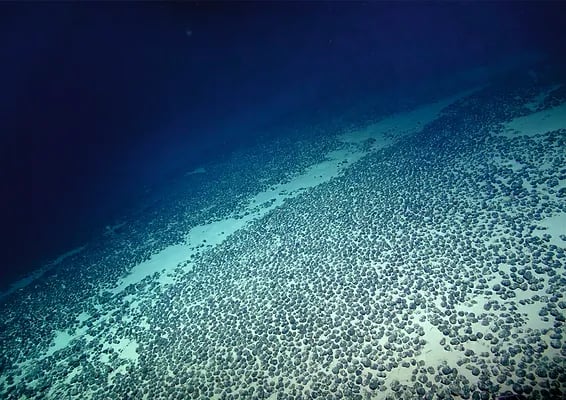The True Cost of Deep-Sea Mining: Are Polymetallic Nodules Worth the Risk?
Polymetallic nodules near Japan hold billions in critical metals for clean energy but mining them threatens deep-sea ecosystems. These nodules support microbes vital for oxygen regulation and carbon storage. Destroying them risks worsening climate change and creating irreversible marine damage.
11/22/20243 min read


The True Cost of Deep-Sea Mining: Are Polymetallic Nodules Worth the Risk?
Imagine a treasure chest buried deep beneath the ocean, holding billions of dollars’ worth of resources critical to the world’s clean energy future. Near Japan’s Minami-Tori-shima Island, the seabed harbors polymetallic nodules rich in cobalt and nickel—metals essential for electric vehicle (EV) batteries, renewable energy storage, and cutting-edge technologies. At current market prices, this treasure trove is valued at a staggering $26.29 billion.
But this treasure comes at an extraordinary price: the destruction of ecosystems that have existed for millions of years. As the world weighs economic opportunity against environmental responsibility, we must ask ourselves: Is this wealth worth the loss of one of Earth’s most fragile and vital ecosystems?
What Are Polymetallic Nodules?
Polymetallic nodules are rock-like formations scattered across the deep-sea floor, containing manganese, nickel, cobalt, and other valuable metals. What makes them unique is their age—they grow at an astonishingly slow rate of millimeters per million years, making them essentially non-renewable.
These nodules aren’t just mineral deposits; they serve as habitats for a wide array of deep-sea organisms. Microbial communities thrive on and around the nodules, playing critical roles in nutrient cycling, carbon storage, and oxygen regulation. In short, they are linchpins in an intricate and poorly understood web of marine life.
The Environmental Toll of Mining
Mining polymetallic nodules disrupts delicate deep-sea ecosystems in ways that could have global consequences.
Habitat Destruction
Removing nodules obliterates the habitats of countless organisms, from microbes to larger marine species. Once these nodules are removed, the affected ecosystems cannot regenerate, given the nodules’ slow formation rate.
Sediment Plumes and Oxygen Loss
Mining operations create massive sediment plumes that drift through the ocean, smothering marine life and reducing oxygen levels. These hypoxic zones, or "dead zones," make survival impossible for most species. During a small-scale mining test, scientists observed a 43% decline in fish and shrimp populations after only two hours of operation.
Carbon and Oxygen Imbalance
The microbes on and around these nodules contribute to regulating carbon and oxygen cycles. By disturbing these microbial ecosystems, mining could release stored carbon back into the ocean and atmosphere, intensifying global warming and further depleting oceanic oxygen levels. This disruption threatens marine biodiversity and could have cascading effects on global oxygen production.
The Economic Allure
Mining these nodules presents a significant opportunity for Japan:
Economic Growth: With cobalt and nickel in high demand, these resources could turbocharge Japan’s economy, reducing reliance on imports and creating jobs.
Technological Advancement: As the world shifts to clean energy, the need for these metals is skyrocketing. Japan could secure a competitive edge in the global clean energy market.
However, these short-term gains come with long-term costs. The very metals intended to support a greener future could destroy one of Earth’s oldest ecosystems, undermining global sustainability goals.
A Paradox of Green Energy
Cobalt and nickel are indispensable for clean energy technologies like EV batteries and renewable energy storage. Yet, mining them from the ocean floor undermines the environmental principles that green energy represents.
This creates a profound paradox: How can we build a sustainable future by destroying ecosystems that are critical to the planet’s health? If green energy is achieved at the expense of oceanic life, can it truly be considered "green"?
Alternatives to Deep-Sea Mining
Before rushing to exploit deep-sea resources, we should consider alternative solutions:
Improved Land-Based Mining: Enhancing the efficiency and sustainability of terrestrial mining operations can help meet demand while avoiding deep-sea damage.
Recycling Metals: Millions of tons of e-waste contain recoverable cobalt and nickel. Scaling up recycling programs can reduce reliance on virgin resources.
Material Innovation: Scientists are exploring alternatives to cobalt and nickel, such as solid-state and sodium-ion batteries, which could lessen the demand for these metals.
Policy and Conservation: Governments and international organizations must regulate or ban deep-sea mining until its long-term environmental impacts are fully understood.
What’s at Stake?
Polymetallic nodules are more than just economic assets—they are ancient relics of Earth’s geological history and lifelines for countless marine species. Mining them risks unraveling ecosystems that took millions of years to form, ecosystems that play a critical role in regulating the planet’s oxygen and carbon cycles.
Do we have the right to destroy these ecosystems for short-term economic gains? Or can we choose a path that prioritizes innovation, conservation, and ethical stewardship of our planet’s resources?
The Verdict
Deep-sea mining offers immense economic promise, but the environmental risks are equally colossal. Polymetallic nodules sustain microbial communities that contribute to dark oxygen cycling—critical processes that help regulate oxygen levels in the ocean. Disrupting these systems could have far-reaching consequences for marine life and humanity.
As Japan contemplates mining its seabed, the world watches closely. This is more than a gold rush; it’s a crossroads for humanity’s relationship with nature. The choice we make today will define the legacy we leave for future generations.
